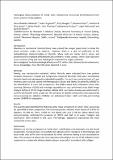| dc.contributor.author | Mereuta, Oana Madalina | |
| dc.contributor.author | Fitzgerald, Seán | |
| dc.contributor.author | Douglas, Andy | |
| dc.contributor.author | Rossi, Rosanna | |
| dc.contributor.author | Silva Santos, Andreia M. | |
| dc.contributor.author | Pandit, Abhay | |
| dc.contributor.author | Thornton, John | |
| dc.contributor.author | Rentzos, Alexandros | |
| dc.contributor.author | Tatlisumak, Turgut | |
| dc.contributor.author | Doyle, Karen M. | |
| dc.contributor.editor | Brain and Neuroscience Advances Journal (volume 3) | |
| dc.date.accessioned | 2020-01-28T13:46:12Z | |
| dc.date.available | 2020-01-28T13:46:12Z | |
| dc.date.issued | 2019-01-01 | |
| dc.identifier.citation | Mereuta, O. M., Fitzgerald, S., Douglas, A., Rossi, R., Silva Santos, A. M., Pandit, A., Thornton, J., Rentzos, A., Tatlisumak, T., Doyle, K. M. (2019). Histological characterization of white clots retrieved by mechanical thrombectomy from acute ischemic stroke patients. Poster presented at the BNA Festival of Neuroscience 2019 (in Brain and Neuroscience Advances, Volume 3), Dublin, Ireland, 14-17 April. | en_IE |
| dc.identifier.uri | http://hdl.handle.net/10379/15743 | |
| dc.description.abstract | Introduction:
Advances in mechanical thrombectomy have created the unique opportunity to study the acute ischemic stroke clot material. However, there is a lack of uniformity in the histopathologic characterization of thrombi. Many clots are mainly red in colour and predominantly composed of Red Blood Cells and Fibrin. In this context, white clots represent a less common entity and their histological composition is largely unknown.
We investigated the histopathological features of 21 white clots retrieved by thrombectomy. To our knowledge, this is the first series reported to date.
Methods:
Twenty one mechanically extracted white thrombi were collected from two partner hospitals: Beaumont Hospital and Sahlgrenska University Hospital. Clots were immediately formalin-fixed and subsequently embedded in paraffin. For each case, serial sections of 3-µm thickness were cut and stained with Hematoxylin & Eosin and Martius Scarlett Blue (MSB) for the identification of main clot components. The MSB-stained slide underwent whole slide scanning (Olympus VS120) and histologic quantification was performed using Orbit Image Analysis Software (Orbit Image Analysis, Idorsia Ltd.). Von Kossa staining was performed to confirm calcification when suspected. The presence of specific components was assessed by immunostaining for platelets (CD42b), von Willebrand Factor (vWF) and fatty-acid binding protein (FABP4) for adipocytes.
Results:
The quantification identified the Platelets as the major component in white clots accounting for up to 90% of their composition. The main components showed mean values of 75.67% for Platelets, 13.36% for Fibrin, 5.07% for Red Blood cells and 3.75% for White Blood Cells Immunostaining confirmed the presence of CD42b and vWF in all cases. Collagen and calcification were present in one case. Interestingly, adipocytes represented the main component in two cases.
Conclusions:
Platelets are the key component of white clots . Calcification and adipocytes are also found occasionally. Increased levels of platelets and calcium confer resistance to thrombolysis and may render clots stiffer and less accessible for stent retrievers leading to low recanalization rates. The presence of adipocytes may represent a histological marker of fat embolism when suspected or a vulnerable atherosclerotic plaque, especially if associated with collagen. | en_IE |
| dc.description.sponsorship | Science Foundation Ireland (Grant Number 13/RC/2073) and Industrial partners Cerenovus | en_IE |
| dc.format | application/pdf | en_IE |
| dc.language.iso | en | en_IE |
| dc.publisher | SAGE Publications | en_IE |
| dc.relation.ispartof | BNA Festival of Neuroscience | en |
| dc.rights | Attribution-NonCommercial-NoDerivs 3.0 Ireland | |
| dc.rights.uri | https://creativecommons.org/licenses/by-nc-nd/3.0/ie/ | |
| dc.subject | stroke | en_IE |
| dc.subject | white clots | en_IE |
| dc.title | Histological characterization of white clots retrieved by mechanical thrombectomy from acute ischemic stroke patients | en_IE |
| dc.type | Conference Paper | en_IE |
| dc.date.updated | 2020-01-22T13:23:42Z | |
| dc.identifier.doi | 10.1177/2398212819855490 | |
| dc.local.publishedsource | https://doi.org/10.1177/2398212819855490 | en_IE |
| dc.description.peer-reviewed | non-peer-reviewed | |
| dc.contributor.funder | Science Foundation Ireland | en_IE |
| dc.contributor.funder | Cerenovus | en_IE |
| dc.internal.rssid | 19531068 | |
| dc.local.contact | Oana Madalina Mereuta. Email: oanamadalina.mereuta@nuigalway.ie | |
| dc.local.copyrightchecked | Yes | |
| dc.local.version | PUBLISHED | |
| dcterms.project | info:eu-repo/grantAgreement/SFI/SFI Research Centres/13/RC/2073/IE/C�RAM - Centre for Research in Medical Devices/ | en_IE |
| nui.item.downloads | 160 | |


